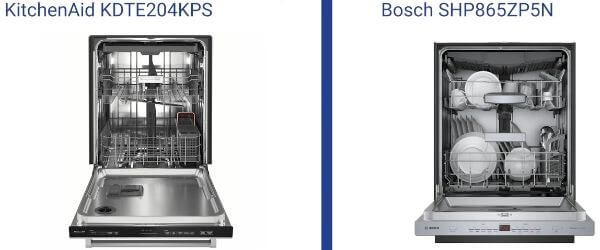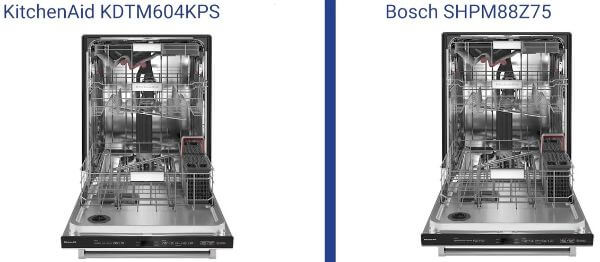Perhaps the single most confusing and popular comparison is KitchenAid vs. Bosch dishwashers.
You read the blogs, watch the videos from both brands and still it’s hard to know which is the right dishwasher for you.
Why? Well, it’s because both are excellent dishwashers and they have recently recently updated their features.
You’ll be happy with either.
They are a bit different in how they wash and dry your dishes as well as the design of the dishwasher racks.
Their silence ratings are somewhat surprising and different from what you may have thought.
In this article, you’ll learn the differences in racking, washing, drying, as well as reliability and a few problems based on 40,000 plus service calls logged by a service department just last year.
In the end, you’ll know which dishwasher is right for you.
Then again, availability and lack of products may change your mind.

Table of Contents
Availability
We’ll start with availability because many of these dishwashers have not been consistently available due to various supply chain issues.
Availability is a huge problem now for several reasons. It will affect how you buy almost every product, not just dishwashers.
And a comparison is close, you’ll learn the best features for how you use a dishwasher, but you’ll have to consider availability.
KitchenAid Dishwashers
The early KitchenAid dishwasher changed the industry because of its solid commercial design.
Kitchen Aid’s weakness was noise, especially when Bosch and Asko started importing quiet dishwashers into the U.S.
While they clean well, it was noisy. They finally addressed that issue, changing the dishwasher to more European design by removing the disposer and adding a filter.
They now have two different series, the TE and TM.
Less expensive TE series dishwashers will have quieter models of 39 decibels.
The TM will have better washing, racking and drying system, but will be noisier at 44 decibels because of their two filter design.
Top models are the 200 series and the 600 series. Yes, only two models.
KitchenAid’s availability is a problem, but their higher end 700 and 800 series don’t justify the price increase.
You can buy KitchenAid’s with the towel bar as a KDT or pocket handle as a KDP.
Bosch Dishwashers
Bosch’s weaknesses are always drying.
Most European stainless steel dishwashers use condensation or the heat from the wash and JetDry to dry your dishes.
It’s decent for plates and silverware, but it doesn’t work as well for less dense items like your Tupperware.
Last year, Bosch improved their drying on some models featuring auto air feature that pops open the dishwasher after the cycle is complete. This will release moisture and speed up the drying process.
Bosch’s better models will have crystal dry using volcanic elements to increase heat and absorb moisture. It’s the best drying available in any dishwasher.
You can buy the Bosch dishwasher with five different fronts.
Reliability
Both are good brands to consider.
The average service rate on a dishwasher in the first year was 12.8% based on our database of sales versus service. Last year, we logged over 40,000 service calls, over 10,000 were just dishwashers.
KitchenAid is now more reliable than Bosch by almost 4.5%, sort of.
However, Thermador is another Bosch made dishwasher. It’s free with other Thermador qualified purchases.
Thermador tends to be less featured, like the less expensive KitchenAid is 3.6% service.
So when you combine Thermador and Bosch, the reliability is about the same to KitchenAid.
The reliability is even more important these days because of the lack of service technicians nationwide.
Similarities
Most upscale dishwashers now have stainless on the inside. It’s more hygienic than plastic because there are no seams for germs and odors to populate.
Plenty of cycles for both, many perform the same function.
They do have a third rack.
However, this year’s KitchenAid dishwasher series is upgraded and different on certain models. Both are at or below 44 decibels.
That number isn’t an accident by the way. It is an unofficial standard for noiseless rating, meaning you won’t hear a 44 decibel dishwasher in the next room while you’re watching TV.
People do tend to be oversold on extra quietness, you shouldn’t make that same mistake. Unless the more expensive dishwasher has some other desired features.
KitchenAid KDTE204 Vs. Bosch SHP865ZP5N
KitchenAid has the better spray on the top vs more of a sprinkler head on the Bosch.
That said, they both wash your dishes.
Both of the third rack for silverware. It’s useful because the third rack will have more room on the bottom rack.
I just moved into an apartment without one. That basket does take a lot of room better suited for my plates.
Like most stainless steel interior dishwashers, KitchenAid uses condensation dry. It’s a fancy term for drying, jet dry and time.
Bosch has auto air on their more expensive SHP865’s and will pop open the door at the end of the cycle to release steam.
The KDT204KPS is KitchenAid’s least expensive available dishwasher. Also their quietest is 39 decibels noiseless, you won’t even hear a hum.
The washing system is also slightly better. However, cycles are about the same.
The comparison is about price mostly with KitchenAid being quieter, Bosch having a better drying cycle.
Next comparison is far more interesting.
You have the best new features in both.
KitchenAid KDTm604 Vs. Bosch SHPM88Z75
KitchenAid’s third rack is the best accommodating, more than any other brand. Also has separate sprays in the rods of the rack.
Bosch has the MyWay rack, allowing you to hold more cups and small dishes.
Bosch has the same sprinkler on the top and then the two under the main racks.
In addition to spray on the rods, KitchenAid has spray on the top, middle and bottom. They claim 4 levels, but it’s really 3 plus the holes in the rack on the fourth.
KitchenAid has also changed the filtering system to two filters so the water will be cleaner as well. The second filter increases the noise from a noiseless 39 dB the 200 to a still quiet 44 dB.
Both companies have made improvements.
KitchenAid lets air from the outside cool the dishwasher’s interior. The steam and moisture attracted the dryer cooler air and dissipated as water.
KitchenAid also has a heating element to absorb moisture. Bosch, however, completely changed how dishwashers dry.
In this dishwasher, they pack a volcanic element, Zeolite to absorb moisture and emit heat for the driest dishes available. Zeolite even works well on plastic.
Panel Readiness
Bosch is clearly better because it fits within a 24 inch cabinet.
You would think this would be a standard feature on dishwashers. However, only Beko, Miele, Asko and Bosch fits seamlessly within cabinets.
KitchenAid and other American dishwashers like GE will protrude outside the cabinet. The difference between a dishwasher looking like a cabinet and a dishwasher looking like a dishwasher with a panel on it.
This comparison is no contest.
Bosch is better for this style. Bosch markets several panel-ready models. Look for the ‘V’ in the model number.
KitchenAid may have changed their whole line but missed this opportunity.
Key Takeaways
Both are excellent choices.
You should consider both because they both have decent features along with good reliability.
Bosch may be a little bit better in our first comparison while KitchenAid has a better wash system.
Bosch has a better drying system in the second.
Last year I said, wait until the ever predictable sales day, Presidents Day, Memorial Day, tax free weekend, Labor Day or Black Friday.
This year, you should really consider the opposite.
And for the time being, buy the best model for you based on what is currently available.
And consider service or at least the best service in your area.

